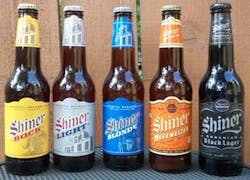A More Efficient Beer Cooler
By Peter Koestler
• Texas' oldest brewery saves 1.8 million gallons of cooling water a year via controlled hydrodynamic cavitation/filtration from VRTX Technologies for evaporative condensers.
The beverage industry has been challenged to find ways to reduce water use. The brewing industry has an especially vital interest in the preservation and quality of water. Not only does its product consist of over 90% water but, during the brewing process, an additional 4-7 barrels (each equaling 31 U.S. gallons) of water are used for every barrel of finished beer.
Objectives of this case study, conducted in 2003, were to: a) provide scale, corrosion and microbiological control to Texas' oldest brewery, b) improve condenser operating efficiency over existing condenser systems c) conserve water by minimizing condenser makeup discharge, d) produce a reduced quantity of condenser bleed that possessed minimal pollution, and e) implement environmental improvements and worker safety wherever possible.
A big concern at the Spoetzl Brewery, in Shiner, TX (est. 1909), was the amount of water the brewery used annually. After installing VRTX's controlled hydrodynamic cavitation (CHC) technology on its three condensers, the brewery saw a significant reduction in discharged water. Operating expenditures were reduced and the facility's workers and the environment are free of harmful chemicals that would otherwise be required. More specific objectives were as follows:
- Achieve performance equal to or better than traditional methods of chemical treatment on the evaporative condenser water that rejects heat from the ammonia compressor system.
- Cut or eliminate toxic and hazardous chemicals and improve worker safety and environmental compliance.
- Make significant water savings with measurement via cycles of concentration and reductions in makeup and blowdown.
- Achieve corrosion control equal to or less than Cooling Technology Institute (CTI) recommendations.
- Scale control equal to or better than those achieved from traditional chemical water treatment.
- Biological control equal to or better than CTI recommendations.
- Generate a reusable water source for non-potable applications from the bleed.
Site Background
The brewery operates a refrigeration system with anhydrous ammonia as the primary coolant. The recompressed ammonia is cooled down in three evaporative condensers with a total cooling capacity of ~1,500 tons and a water volume of ~3,000 gallons. Municipal water is used as makeup for this cooling system. On average, the makeup water contains 130 ppm (as CaCO3) of total hardness, 100 ppm (as CaCO3) of calcium hardness and 400 ppm (as CaCO3) of total alkalinity. The pH is around 7.7 with a TDS of approximately 700 ppm. The original chemical water treatment system was designed with a makeup water holding tank into which additives were automatically injected, based on water conductivity. From this holding tank, the cooling water was pumped up to the towers on the roof.
With the chemical treatment, cycles of concentration were kept low with repeated bleed-off to assure water quality. The cycles of concentration were 2-2.5 during the summer months and below 2 for the rest of the year, resulting in an average of around 2. Despite these efforts, significant calcium carbonate deposit accumulated around the condenser tubes and inside the condensers.
Formation of inorganic scale on condenser tubes significantly reduces the heat transfer rate across condenser tubes; and, consequently, excess electric energy is required to run the ammonia compressors. Under chemical treatment, bacteria counts averaged in excess of 10,000 colony forming units per milliliter (CFU/ml).
Non-Chemical Treatment
In August 2001, the traditional chemical treatment program was replaced with a VRTX system, a patented non-chemical technology for cooling water treatment. This system consists of a hydrodynamic cavitation (HDC) device and a filtration/separation unit. Based on the water volume in the system, makeup feed rates and water chemistry, a 60-gpm HDC unit and a 50-gpm disc filter were installed. Results after installation were as follows:
- Old scale was gradually removed and no new scale has formed: Two weeks after installation, it was noticed the hard scale on condenser tubes started to soften with most removed after two months of operation.
- Very low bacteria counts: Total bacteria counts in cooling water normally range from 400 to 2,500 CFU/ml, measured by standard Pour Plate Method (Standard Method 9215 B). Over nearly a 2-½ year period, the bacteria counts averaged 1,000 CFU/ml.
- Low corrosion rates: Corrosion rates of less than 2.2 mils per year (mpy) for galvanized steel and 2.5 mpy for carbon steel and less than 0.3 mpy for copper alloy.
- Cycles of concentration are also calculated using recorded data: Prior to HDC installation the cycles were 2.3. For 28 months since then, the average was 6.9 — ranging from 5.4 to 7.9.
Water Savings
The brewery installed water meters on both makeup and blowdown lines 47 days prior to the installation of the VRTX system. Readings from both meters have been recorded regularly ever since. During the 47 days prior to installation, the blowdown was 395,600 gallons and makeup consumption was 901,600 gallons. Since the installation, the blowdown rate has decreased significantly. It took 311 days to reach the same amount of blowdown, as opposed to 47 days with chemical treatment.
Over the 28-month treatment period, total makeup water consumption was 7.52 million gallons and total blowdown volume 1.09 million gallons. The makeup consumption rate and blowdown rate were 19,115 and 8,387 gallons per day (gpd), respectively, prior to VRTX treatment. With it, the average blowdown rate was reduced to 1,323 gpd and the makeup rate to 7,624 gpd. The discharge water also now contains no hazardous chemicals, making it available for reuse
Conclusion
“That our family-owned company chose to install VRTX technology at its sister brewery in Berkeley, CA, based on Spoetzl's recommendations, speaks volumes,” said Peter Takacs, Spoetzl Brewery's Quality Assurance Manager.
About the Author: Peter Koestler is the brewery engineer for The Gambrinus Company in San Antonio, TX, which acquired the Spoetzl Brewery in 1989. He thanks VRTX Technologies' Wiley Wang and Robert Kelsey for their help on this article. Contact: 800-722-0476 or www.vrxtech.com



